
Phlox is a genus of 68 species of perennial and annual plants in the family Polemoniaceae. They are found mostly in North America in diverse habitats from alpine tundra to open woodland and prairie. Some flower in spring, others in summer and fall. Flowers may be pale blue, violet, pink, bright red, or white. Many are fragrant.

Gilia is a genus of between 25 and 50 species of flowering plants in the Polemoniaceae family and is related to phlox. These Western native plants are best sown in sunny, well-draining soil in the temperate and tropical regions of the Americas, where they occur mainly in desert or semi-desert habitats

Schinia, commonly called flower moths, is a large genus of moths belonging to the family Noctuidae. The genus has a Holarctic distribution with the vast majority of species being found in North America, many with a very restricted range and larval food plant.

Phlox pilosa, the downy phlox or prairie phlox, is an herbaceous plant in the family Polemoniaceae. It is native to eastern North America, where it is found in open areas such as prairies and woodlands.

Phlox is an unincorporated community in southern Union Township, Howard County, Indiana, United States. It lies at the intersection of State Road 26 with County Road 1100 East.

Gilia cana is a species of flowering plant in the phlox family known by the common name showy gilia. It is native to California and Nevada where it grows in open areas with gravelly and sandy soils, such as desert and rocky slopes. The Mojave Desert range of some subspecies may extend into Arizona.
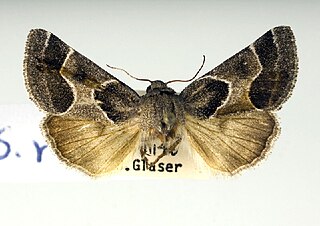
Schinia rivulosa, the ragweed flower moth, is a moth of the family Noctuidae. The species was first described by Achille Guenée in 1852. It is found in North America from Quebec to Florida, west to Arizona, north to Oregon and North Dakota. There is one generation per year.

Schinia arcigera, the arcigera flower moth, is a moth of the family Noctuidae. The species was first described by Achille Guenée in 1852. It is found in North America from Nova Scotia to Florida, west to Arizona and Idaho, north to Saskatchewan.

Schinia jaguarina, the jaguar flower moth, is a moth of the family Noctuidae. The species was first described by Achille Guenée in 1852. It is found on North America's Great Plains from Saskatchewan and Alberta south to Texas, eastward on coast to Florida and westward in south to Arizona. In Mexico it is found down to Mexico City.
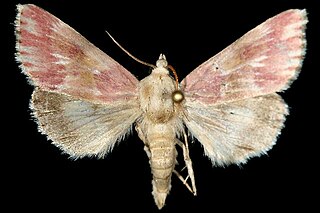
The bleeding flower moth is a moth of the family Noctuidae. It is found from North Carolina to Florida, west to Texas, north to Montana. There is also a disjunct population in Ontario.

Schinia aurantiaca is a moth of the family Noctuidae. It is found in North America, including California and Arizona.
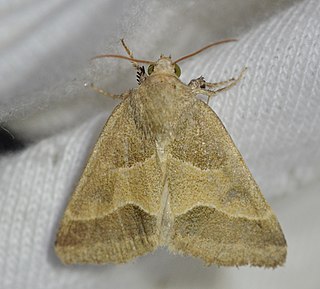
Schinia gracilenta, the slender flower moth or iva flower moth, is a moth of the family Noctuidae. The species was first described by Jacob Hübner in 1818. It is found from the US states of New York to Florida and Nebraska to Arizona. The species is listed as endangered in Connecticut.
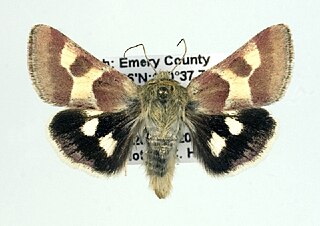
Schinia suetus is a moth of the family Noctuidae first described by Augustus Radcliffe Grote in 1873. It is widespread in the mountains of western North America, from southern Alberta west to British Columbia, south at least to Colorado and California, east to Idaho and New Mexico.
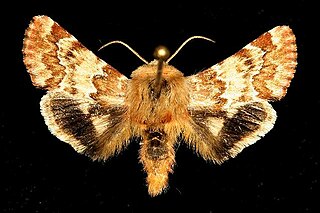
Schinia septentrionalis, the northern flower moth, is a moth of the family Noctuidae. The species was first described by Francis Walker in 1858. It is found in North America from Missouri to Quebec to South Carolina and Louisiana. Records include Colorado, Oklahoma, South Dakota and Texas. It is listed as threatened in the US state of Connecticut.

Schinia nundina, the goldenrod flower moth, is a moth of the family Noctuidae. The species was first described by Dru Drury in 1773. It is found in North America from Minnesota to southern Ontario and Nova Scotia, south to central Florida and southern Texas. Records include Arizona, Kansas, Nebraska, New York, Maryland, Oklahoma and South Carolina.
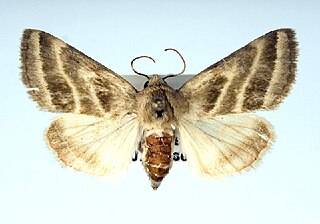
Schinia trifascia, the three-lined flower moth, is a moth of the family Noctuidae. The species was first described by Jacob Hübner in 1818. It is found in North America from Ontario and Massachusetts south to Florida and west to Arizona, Colorado and Wyoming. It has also been reported from Louisiana.

Schinia obscurata, the obscure schinia moth, is a moth of the family Noctuidae. It is found from Ontario and Quebec south into the United States, where it has been recorded from Illinois, New Jersey, South Carolina, Wisconsin, Kansas, Montana, Nebraska, North Dakota, Oklahoma and Texas.

Schinia nubila, the camphorweed flower moth or brown flower moth, is a moth of the family Noctuidae. The species was first described by Herman Strecker in 1876. It is found from the US states of Oklahoma to New Jersey, south to Florida and Texas. Its range is expanding in the northeast. Furthermore, recorded from Colorado, Kansas, Oklahoma, Arkansas, North Carolina, South Carolina and Maryland.
Schinia aetheria is a moth of the family Noctuidae first described by William Barnes and James Halliday McDunnough in 1912. It is found in North America, including Arizona, Nevada, New Mexico and Utah.
















